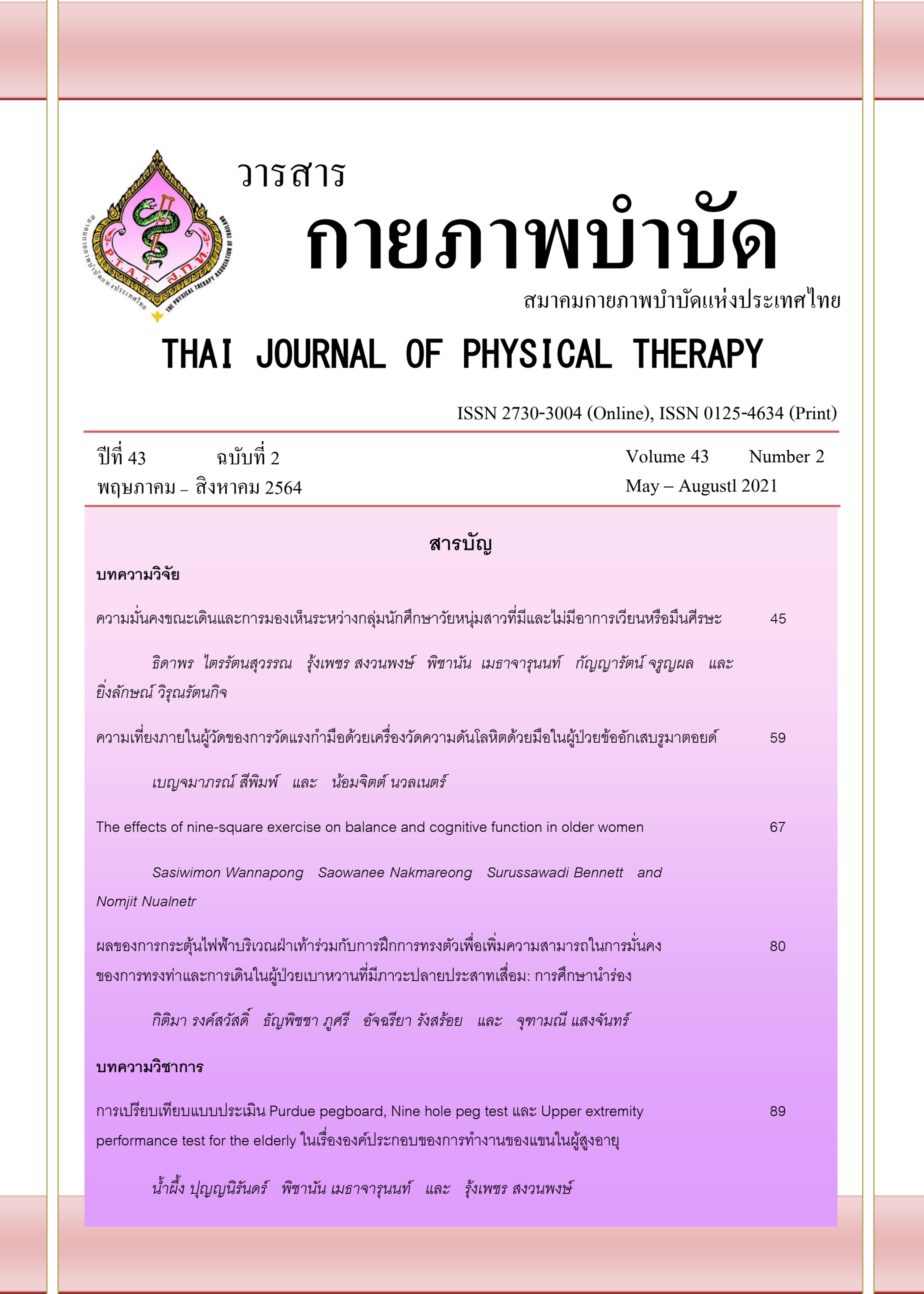Intra-rater reliability of grip strength measurement by using a manual sphygmomanometer in patients with rheumatoid arthritis
Main Article Content
Abstract
Background: Grip strength measurement is an essential clinical assessment for specifying prognosis and treatment plans of patients with rheumatoid arthritis (RA). At present, a manual sphygmomanometer is applied as an instrument for measuring grip strength. However, reports about psychometric properties of this instrument in patients with RA are limited.
Objective: To evaluate intra-rater reliability of grip strength measurement by using a manual sphygmomanometer in patients with RA.
Methods: Participants were 89 patients with RA (60 females and 29 males). Each of them was asked to use his/her dominant hand to continuously squeeze an air-filled sphygmomanometer cuff, which was rolled and placed inside a fabric bag, as hard as possible for 5 seconds. The maximum and stable pressure peak reading during the 5-second period was recorded. Two trials were conducted with a 30-second rest between trials. Then, the same procedure was applied to the non-dominant hand. Intra-rater reliability of the grip strength measurement of each hand was evaluated by the ICC3,1 with a statistical significance at p<0.05.
Results: The ICC3,1 of the grip strength measurement were 0.95 (95% CI = 0.93 to 0.97, p<0.001) and 0.99 (95% CI = 0.98 to 0.99, p<0.001) for dominant and non-dominant hands, respectively.
Conclusion: Grip strength measurement by using a manual sphygmomanometer in patients with RA in moderate severity level showed very high intra-rater reliability. Therefore, this instrument is possibly an alternative measurement of grip strength in patients with RA. Evaluations for other psychometric properties of the instrument are suggested to promote its extensive use.
Article Details
References
National Institute for Health and Clinical Excellence: Rheumatoid arthritis: the management of rheumatoid arthritis in adults. London: National Institute for Health and Clinical Excellence, 2009.
Fraser A, Vollow J, Preston A, Cooper RG. Predicting ‘normal’ grip strength for rheumatoid arthritis patients. Rheumatology. 1999; 38(6): 521-8.
Shipham I, Pitout SJ. Rheumatoid arthritis: hand function, activities of daily living, grip strength and essential assistive devices. Curationis. 2003; 26(3): 98-106.
Ugurlu U, Ozdogan H. Conversion of grip strength scores between Jamar dynamometer and a modified sphygmomanometer in patients with rheumatoid arthritis. Isokinet Exerc Sci. 2013; 21(4): 263-72.
Pujianita L, Prabowa T, Prananta MS. Prediction of Jarmar grip strength value using modified aneroid sphygmomanometer cuff method. Int J Integr Health Sci. 2017; 5(1): 1-7.
Souza LAC, Martins JC, Moura JB, Teixeira-Salmela LF, De Paula FV, Faria CDCM. Assessment of muscular strength with the modified sphygmomanometer test: what is the best method and source of outcome values?. Braz J Phys Ther. 2014; 18(2): 191-200.
Martins JC, Teixeira-Salmela LF, Souza LAC, Aguiar LT, Lara EM, Moura JB, et al. Reliability and validity of the modified sphygmomanometer test for the assessment of strength of upper limb muscles after stroke. J Rehabil Med. 2015; 47(8): 697-705.
Tansakul P, Panuwannakorn M. Grip strength in normal population and rheumatoid arthritis patients: comparison of sphygmomanometer and hydraulic dynamometer. J Thai Rehabil Med. 2007;17(3): 86-90.
Bastiana YD, Tulaar ABM, Hartono S, Albar Z. Effect of range of motion and isometric strengthening exercises on grip strength and hand function in rheumatoid arthritis patients. Univ Med. 2008; 27(8): 157-64.
Khiewyoo J. Statistical methods for health measurement. Khon Kaen: Klang Na Na Vithaya, 2014.
Portney LG, Watkins MP. Foundations of clinical research: applications to practice. 2nd ed. Upper Saddle River: Prentice-Hall, 2000.
Bonett DG. Sample size requirements for estimating intraclass correlations with desired precision. Statist Med. 2002; 21(9): 1331-5.
Breedland I, Scheppingen C, Leijsma M, Jansen N, Weert E. Effects of group-based exercise and educational program on physical performance and disease self-management in rheumatoid arthritis: a randomized controlled study. Phys Ther. 2011; 91(1): 879-93.
Farheen K, Agarwal SK. Assessment of disease activity and treatment outcomes in rheumatoid arthritis. J Manag Care Pharm. 2011; 17(9 Suppl B): S09-13.
Hamilton GF, McDonald C, Chenie TC. Measurement of grip strength: validity and reliability of the sphygmomanometer and Jamar grip dynamometer. J Orthop Sports Phys Ther. 1992; 16(5): 215-9.
Hillman TE, Nunes QM, Hornby ST, Stange Z, Neal KR, Rowlands BJ, et al. A practical posture for hand grip dynamometry in the clinical setting. Clin Nutr. 2005; 24(2): 224-8.
Domholdt E. Physical therapy research. 2nd ed. Philadelphia: W.B. Saunders, 2000.

